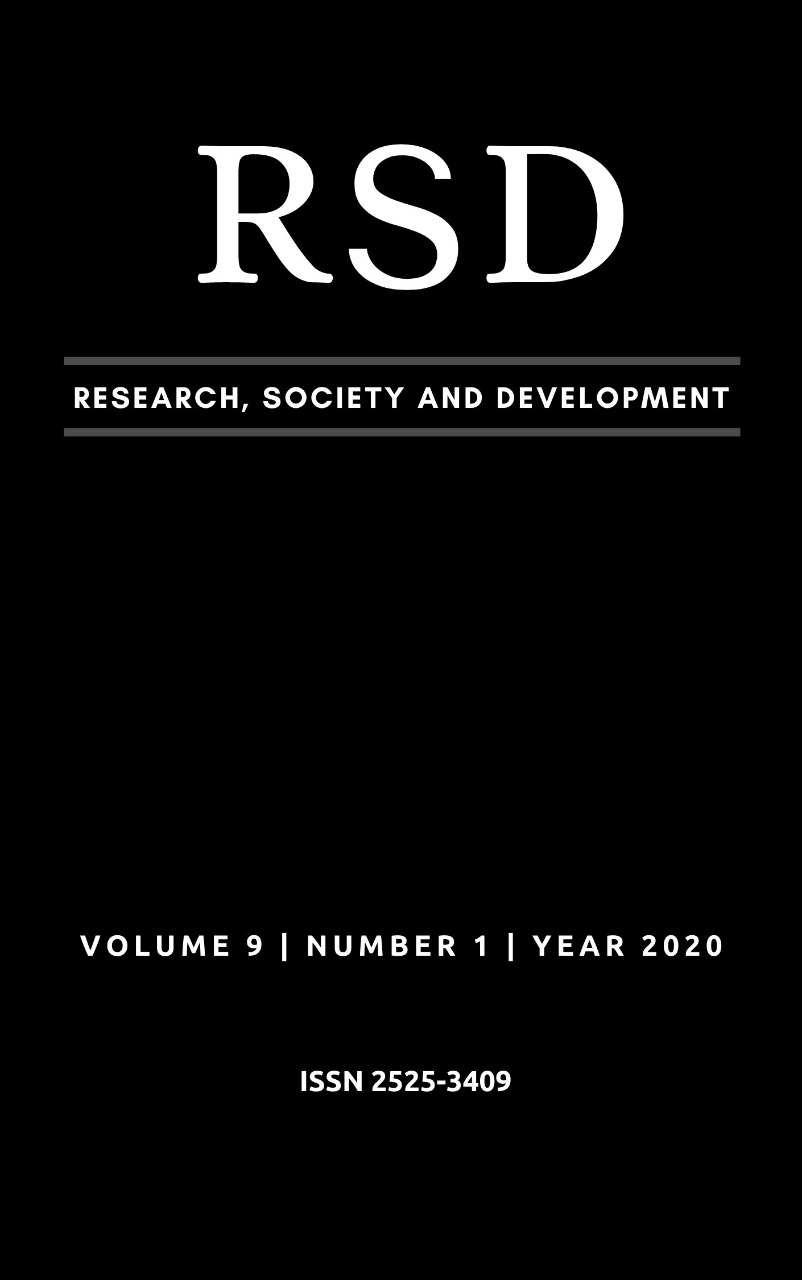Avaliação do estado nutricional de crianças de uma escola municipal de Campina Grande-Paraíba
DOI:
https://doi.org/10.33448/rsd-v9i1.1789Palavras-chave:
Avaliação Nutricional, Obesidade Pediátrica, Comportamento Alimentar, AntropometriaResumo
O presente estudo teve como objetivo avaliar o estado nutricional de crianças de 4 a 10 anos de idade em uma Escola municipal de Campina Grande-Paraíba, através dos parâmetros Índice de Massa Corpórea (IMC) para Idade, Peso para Idade (P/I) e Estatura para Idade (E/I). Trata-se de uma pesquisa de campo, de natureza descritiva e caráter exploratório tendo como abordagem o método quantitativo. A amostra foi composta por 33,3% da população, por ser considerado uma amostra representativa, correspondendo a 50 crianças de ambos os sexos, entre a faixa etária de 4 a 10 anos e matriculados na escola municipal. No dia da coleta dos dados as crianças foram destinadas a uma sala reservada, no qual foi realizada a antropometria. Os dados coletados foram analisados através do banco de dados da plataforma SPSS (Statistical Package for the Social Sciences) na versão 22 dos parâmetros de IMC para Idade, Peso para Idade, Estatura para Idade posteriormente interpretados com base nos gráficos de crescimento e identificados pelas tabelas de diagnóstico nutricional da OMS. Verificou-se que no parâmetro Estatura para Idade, as crianças com estatura adequada para idade, correspondendo 92% (n=46). No diagnóstico de baixa estatura para a idade, apresentou 8% (n=4). O parâmetro de IMC para Idade, 8% (n=4) indicou magreza; no diagnóstico de eutrofia apresentaram 40% (n=20); de excesso de peso totalizou 52% (n=26). No parâmetro de Peso para Idade, 12% (n=7) apresentaram peso inferior para a idade; no peso adequado para a idade apresentou 62% (n=31), e de peso elevado para a idade 24% (n=12). Acompanhar o estado nutricional das crianças é de extrema importância, pois possibilita avaliar o real estado nutricional para sua idade, assim como seu desenvolvimento em uma fase que ocorre diversas alterações e maturação fisiológica e mental.
Referências
Biscegli, T.S. et al. (2007). Avaliação do estado nutricional e do desenvolvimento neuropsicomotor em crianças frequentadoras de creche. Revista Paul Pedriat., 25(4): 337-342.
Brasil. (2011). Orientações para a coleta e análise de dados antropométricos em serviços de saúde: Norma Técnica do Sistema de Vigilância Alimentar e Nutricional-SISVAN.
Brasil. (2018). Curvas de crescimento da Organização Mundial de Saúde – OMS. Brasília: Ministério da Saúde.
Brasil. (2018). Sobre o PNAE. Brasília: Ministério da Educação.
Caisan. (2011). Câmara Interministerial de Segurança Alimentar e Nutricional. Plano Nacional de Segurança Alimentar e Nutricional: 2012/2015. Brasília: CAISAN.
Carvalho, I.L. de et al. (2014). Estado nutricional de escolares da rede pública de ensino. Revista Rene, 15(2): 291-297.
Carvalho, N.C. et al. (2014). Hábitos alimentares na escola infantil. Revista Científica Interdisciplinar, 1(2).
De Obesidade, D.B. (2018). ABESO - Associação Brasileira de Estudo da Obesidade e Síndrome Metabólica.
Gil, A. C. (2008). Métodos e técnicas de pesquisa social. 6. ed. Editora Atlas SA.
Michel, M. H. (2005). Metodologia e pesquisa científica em ciências sociais: um guia para acompanhamento da disciplina e elaboração de trabalhos monográficos. São Paulo: Atlas, 421-437.
Pedraza, D.F. et al. (2016). Estado nutricional e hábitos alimentares de escolares de Campina Grande, Paraíba, Brasil. Campina Grande: Universidade Estadual da Paraíba.
Pereira, A.S. et al. (2018). Metodologia da pesquisa científica. [e-book]. Santa Maria. Ed. UAB/NTE/UFSM.
Ramos, L., Pereira, M. L. C., Mota, M. A., Jacob, T., Nakaoka, V. Y., & Kashibawakara, V. (2014). A transição da desnutrição para a obesidade. Braz J Surg Clin Res, 5(1).
Rosa, S. A. M., & Araújo, C. G. (2016). PERFIL SOCIOECONÔMICO E NUTRICIONAL DE ESCOLARES EM UMA INSTITUIÇÃO PÚBLICA DE ENSINO EM JAGUARIBARA-CE. Revista de APS, 19(4).
Santos, F.P.C. et al. (. Journal of Human Growth and Development, 2015). Estado nutricional de crianças beneficiadas pelo Programa Bolsa Família, 25 (3): 313-318.
Silva, J. M. S. (2018). Perfil do estado nutricional e do consumo alimentar de crianças de uma escola do município de Vitória de Santo Antão-PE (Bachelor's thesis).
Silveira, F.J.F. & Lamounier, J.A. (2009). Avaliação nutricional de crianças do Vale do Alto Jequitinhonha com a utilização das novas curvas de crescimento do NCHS e da OMS. Revista Paulista de Pediatria, São Paulo, 27(2): 133-138.
WHO. (2009). Infant and Young child feeding: model chapter for textbooks for medical students and allied health professionals. [S.l.].
Downloads
Publicado
Edição
Seção
Licença
Autores que publicam nesta revista concordam com os seguintes termos:
1) Autores mantém os direitos autorais e concedem à revista o direito de primeira publicação, com o trabalho simultaneamente licenciado sob a Licença Creative Commons Attribution que permite o compartilhamento do trabalho com reconhecimento da autoria e publicação inicial nesta revista.
2) Autores têm autorização para assumir contratos adicionais separadamente, para distribuição não-exclusiva da versão do trabalho publicada nesta revista (ex.: publicar em repositório institucional ou como capítulo de livro), com reconhecimento de autoria e publicação inicial nesta revista.
3) Autores têm permissão e são estimulados a publicar e distribuir seu trabalho online (ex.: em repositórios institucionais ou na sua página pessoal) a qualquer ponto antes ou durante o processo editorial, já que isso pode gerar alterações produtivas, bem como aumentar o impacto e a citação do trabalho publicado.


